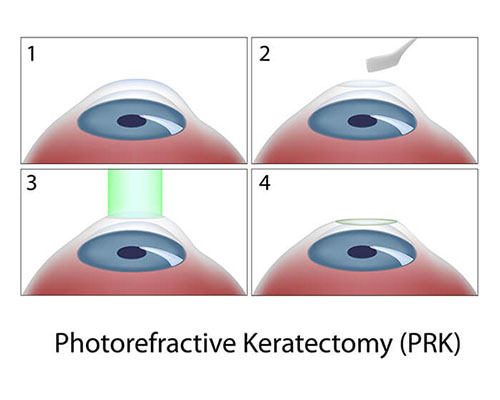What is PRK?

PRK (photorefractive keratectomy) was the first laser refractive surgery technique performed on a widespread basis. PRK entails the removal of the cells of the epithelium.
This begins with using a laser to expose the stromal tissue. The special excimer laser is then used to remove fine layers of the stroma in a pattern designed to make appropriate changes to an individual patient’s vision.
The epithelium regenerates naturally. The entire process is performed under topical anesthesia (eye drops).
Understanding LASIK/PRK
LASIK (Laser-Assisted in-situ Keratomileusis)
During LASIK, the cornea is reshaped by the Excimer laser- by reshaping the cornea, it works better to focus light into the eye and onto the retina, providing clearer vision than before.
But first, a flap is created in order to reshape the cornea and to assist in a quicker recovery.
The Flap is created by Intralase laser (no blades). This laser directs laser energy precisely to create a thin, hinged flap, which then is lifted temporarily from the eye’s surface or cornea.
The surgeon folds the hinged flap back out of the way, and then removes some corneal tissue underneath using an excimer laser. The excimer laser uses a cool ultraviolet light beam to precisely remove (“ablate”) very tiny bits of tissue from the cornea to reshape it.
LASIK VS. PRK
PRK (photorefractive keratectomy) once was the most common refractive surgery procedure before LASIK was developed as a more popular alternative. Both PRK and LASIK are grouped under the umbrella “laser eye surgery,” but each is a little different when it comes to advantages and disadvantages.
LASIK patients have less discomfort and obtain good vision more quickly — whereas, improvement with PRK is gradual and takes days, weeks, or even months. But many surgeons prefer PRK in circumstances such as when patients have thin corneas.
PRK is performed with an excimer laser, which uses a cool ultraviolet light beam to precisely remove (“ablate”) very tiny bits of tissue from the surface of the cornea in order to reshape it.
When you reshape the cornea in the right way, it more precisely focuses light into the eye and onto the retina, providing clearer vision than before.
Both nearsighted and farsighted people can benefit from PRK or LASIK. With nearsighted people, the goal is to flatten the too-steep cornea; with farsighted people, a steeper cornea is desired. Also, excimer lasers can correct astigmatism, by smoothing an irregular cornea into a more normal shape.
To find out whether you are a candidate, visit our LASIK Self-Test page. If you are interested in learning more about PRK, please contact us today!

